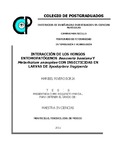| dc.contributor.author | Rivero Borja, Maribel. | |
| dc.creator | RIVERO BORJA, MARIBEL; 484214 | |
| dc.date.accessioned | 2018-06-22T19:08:23Z | |
| dc.date.available | 2018-06-22T19:08:23Z | |
| dc.date.issued | 2015 | |
| dc.identifier.uri | http://hdl.handle.net/10521/2661 | |
| dc.description | Tesis (Maestría en Ciencias, especialista en Entomología y Acarología).- Colegio de Postgraduados, 2015. | es_MX |
| dc.description.abstract | Con intención de mejorar el control de Spodoptera frugiperda (gusano cogollero) se probaron combinaciones de insecticidas con hongos sobre larvas de tercer ínstar de esa plaga. Se usaron combinaciones de las CL50 de clorpirifós etil y spinosad (0.24 y 0.025 g mL-1, respectivamente) con suspensiones de esporas de aislamientos de Beauveria bassiana (Bb88) y Metarhizium anisopliae (ETL) (1x108 esporas mL-1) en tres secuencias de aplicación: hongo seguido (a las 24 h) de insecticida; hongo simultáneo con insecticida e insecticida seguido de hongo. Como respuesta se observó la mortalidad de las larvas tratadas y la esporulación de los cadáveres. En la mortalidad influyeron los tres factores: insecticidas, los hongos y la secuencia. En general, bajo las combinaciones se obtuvieron mortalidades similar a las de los testigos de insecticida, pero se aumentó la esporulación, implicando que los hongos infectaron más huéspedes cuando se aplicaron en combinación con los insecticidas que cuando se aplicaron solos (P<0.0001). Spinosad fue mejor promotor de la infección (esporulación) que clorpirifós etil. La secuencia Bb88-spinosad (aplicación simultánea) produjo mayor mortalidad que su testigo de insecticida. El aislamiento Bb88 fue antagónico con clorpirifós etil respecto a la mortalidad cuando el hongo se aplicó antes o simultáneamente con el insecticida. Se discute el potencial de las combinaciones de hongos con insecticidas para mejorar el desempeño de los hongos entomopatógenos, el papel de las secuencias en ese desempeño y las posibles causas del antagonismo observado entre Bb88 y clorpirifós etil. _______________ INTERACTION OF ENTOMOPATHOGENIC FUNGI Beauveria bassiana AND Metarhizium anisopliae WITH INSECTICIDES IN LARVAE OF Spodoptera frugiperda. ABSTRACT: Aiming to improve control of Spodoptera frugiperda (fall armyworm), combinations of insecticides with fungi were tested against third instar larvae of this pest. Combinations of the LC50 of ethyl chlorpyrifos and spinosad (0.24 and 0.025 g mL-1, respectively) were used with suspensions of spores from isolates of Beauveria bassiana (Bb88) and Metarhizium anisopliae (ETL) (1x108 spores mL-1) in three application sequences: fungus followed (24 h later) by insecticide, fungus and insecticide simultaneously, and insecticide followed by fungus. The response observed was mortality of the treated larvae and sporulation on cadavers. The three factors, insecticides, fungi and the sequence, influenced mortality. In general, the combinations achieved mortalities similar to those of the insecticide controls, but sporulation increased, meaning that the fungi infected more hosts when they were applied in combination with the insecticides than when they were applied alone (P<0.0001). Spinosad was a better promotor of infection (sporulation) than ethyl chlorpyrifos. The sequence Bb88-spinosad (simultaneous application) produced higher mortality than its insecticide control. The Bb88 isolate was antagonistic with chlorpyrifos in terms of mortality when the fungus was applied before or simultaneously with the insecticide. We discuss the potential of fungus-insecticide combinations for better performance of entomopathogenic fungi, the role of the sequence in their performance and the possible causes of the antagonism observed between Bb88 and chlorpyrifos. | es_MX |
| dc.description.sponsorship | Consejo Nacional de Ciencia y Tecnología (CONACyT). | es_MX |
| dc.language.iso | spa | es_MX |
| dc.rights.uri | http://creativecommons.org/licenses/by-nc-nd/4.0 | |
| dc.subject | Secuencias de aplicación | es_MX |
| dc.subject | Esporulación | es_MX |
| dc.subject | Gusano cogollero | es_MX |
| dc.subject | Clorpirifós etil | es_MX |
| dc.subject | Spinosad | es_MX |
| dc.subject | Hongos entomopatógenos | es_MX |
| dc.subject | Antagonismo | es_MX |
| dc.subject | Application sequences | es_MX |
| dc.subject | Sporulation | es_MX |
| dc.subject | Fall armyworm | es_MX |
| dc.subject | Ethyl chlorpyrifos | es_MX |
| dc.subject | Entomopathogenic fungi | es_MX |
| dc.subject | Antagonism | es_MX |
| dc.subject | Entomología y Acarología | es_MX |
| dc.subject | Maestría | es_MX |
| dc.title | Interacción de los hongos entomopatógenos Beauveria bassiana y Metarhizium anisopliae con insecticidas en larvas de Spodoptera frugiperda | es_MX |
| dc.type | Tesis | es_MX |
| Tesis.contributor.advisor | Pérez Panduro, Alejandro. | |
| Tesis.contributor.advisor | Guzmán Franco, Ariel W. | |
| Tesis.contributor.advisor | Rodríguez Leyva, Esteban. | |
| Tesis.contributor.advisor | Santillán Ortega, Candelario. | |
| Tesis.date.submitted | 2015 | |
| Tesis.date.accesioned | 2015-04-17 | |
| Tesis.date.available | 2015-04-20 | |
| Tesis.format.mimetype | pdf | es_MX |
| Tesis.format.extent | 721 KB | es_MX |
| Tesis.subject.nal | Spodoptera frugiperda | es_MX |
| Tesis.subject.nal | Beauveria bassiana | es_MX |
| Tesis.subject.nal | Metarhizium anisopliae | es_MX |
| Tesis.subject.nal | Plagas de plantas | es_MX |
| Tesis.subject.nal | Plant pests | es_MX |
| Tesis.subject.nal | Maíz | es_MX |
| Tesis.subject.nal | Corn | es_MX |
| Tesis.subject.nal | Insecticidas | es_MX |
| Tesis.subject.nal | Insecticides | es_MX |
| Tesis.subject.nal | Lambda-cihalotrina | es_MX |
| Tesis.subject.nal | Lambda-cyhalothrin | es_MX |
| Tesis.subject.nal | Toxicidad | es_MX |
| Tesis.subject.nal | Toxicity | es_MX |
| Tesis.rights | Acceso abierto | es_MX |
| Articulos.subject.classification | Hongos como agentes biológicos para el control de plagas | es_MX |
| dc.type.conacyt | masterThesis | |
| dc.identificator | 6 | |
| dc.contributor.director | PEREZ PANDURO, ALEJANDRO; 62376 | |


